A Python package for pharmacogenomics (PGx) research
Project description






Introduction
The main purpose of the PyPGx package, which is completely free and open source, is to provide a unified platform for pharmacogenomics (PGx) research.
The package is written in Python, and supports both command line interface (CLI) and application programming interface (API) whose documentations are available at the Read the Docs.
PyPGx can be used to predict PGx genotypes and phenotypes using various genomic data, including data from next-generation sequencing (NGS), single nucleotide polymorphism (SNP) array, and long-read sequencing. Importantly, PyPGx is compatible with both of the Genome Reference Consortium Human (GRCh) builds, GRCh37 (hg19) and GRCh38 (hg38).
There are currently 58 pharmacogenes in PyPGx:
ABCB1 |
CACNA1S |
CFTR |
CYP1A1 |
CYP1A2 |
CYP1B1 |
CYP2A6/CYP2A7 |
CYP2A13 |
CYP2B6/CYP2B7 |
CYP2C8 |
CYP2C9 |
CYP2C19 |
CYP2D6/CYP2D7 |
CYP2E1 |
CYP2F1 |
CYP2J2 |
CYP2R1 |
CYP2S1 |
CYP2W1 |
CYP3A4 |
CYP3A5 |
CYP3A7 |
CYP3A43 |
CYP4A11 |
CYP4A22 |
CYP4B1 |
CYP4F2 |
CYP17A1 |
CYP19A1 |
CYP26A1 |
DPYD |
F5 |
G6PD |
GSTM1 |
GSTP1 |
GSTT1 |
IFNL3 |
NAT1 |
NAT2 |
NUDT15 |
POR |
PTGIS |
RYR1 |
SLC15A2 |
SLC22A2 |
SLCO1B1 |
SLCO1B3 |
SLCO2B1 |
SULT1A1 |
TBXAS1 |
TPMT |
UGT1A1 |
UGT1A4 |
UGT2B7 |
UGT2B15 |
UGT2B17 |
VKORC1 |
XPC |
Your contributions (e.g. feature ideas, pull requests) are most welcome.
Installation
Following packages are required to run PyPGx:
Package |
Anaconda |
PyPI |
|---|---|---|
fuc |
✅ |
✅ |
scikit-learn |
✅ |
✅ |
openjdk |
✅ |
❌ |
There are various ways you can install PyPGx. The recommended way is via conda (Anaconda):
$ conda install -c bioconda pypgxAbove will automatically download and install all the dependencies as well. Alternatively, you can use pip (PyPI) to install PyPGx and all of its dependencies except openjdk (i.e. Java JDK must be installed separately):
$ pip install pypgxFinally, you can clone the GitHub repository and then install PyPGx locally:
$ git clone https://github.com/sbslee/pypgx
$ cd pypgx
$ pip install .The nice thing about this approach is that you will have access to development versions that are not available in Anaconda or PyPI. For example, you can access a development branch with the git checkout command. When you do this, please make sure your environment already has all the dependencies installed.
Resource bundle
Starting with the 0.12.0 version, reference haplotype panel files and structural variant classifier files in PyPGx are moved to the pypgx-bundle repository (only those files are moved; other files such as allele-table.csv and variant-table.csv are intact). Therefore, the user must clone the pypgx-bundle repository with matching PyPGx version to their home directory in order for PyPGx to correctly access the moved files:
$ cd ~
$ git clone --branch 0.13.0 --depth 1 https://github.com/sbslee/pypgx-bundleThis is undoubtedly annoying, but absolutely necessary for portability reasons because PyPGx has been growing exponentially in file size due to the increasing number of genes supported and their variation complexity, to the point where it now exceeds upload size limit for PyPI (100 Mb). After removal of those files, the size of PyPGx has reduced from >100 Mb to <1 Mb.
Structural variation detection
Many pharmacogenes are known to have structural variation (SV) such as gene deletions, duplications, and hybrids. You can visit the Genes page to see the list of genes with SV.
Some of the SV events can be quite challenging to detect accurately with NGS data due to misalignment of sequence reads caused by sequence homology with other gene family members (e.g. CYP2D6 and CYP2D7). PyPGx attempts to address this issue by training a support vector machine (SVM)-based multiclass classifier using the one-vs-rest strategy for each gene for each GRCh build. Each classifier is trained using copy number profiles of real NGS samples as well as simulated ones.
You can plot copy number profile and allele fraction profile with PyPGx to visually inspect SV calls. Below are CYP2D6 examples:
SV Name |
Gene Model |
Profile |
|---|---|---|
Normal |

|

|
DeletionHet |

|
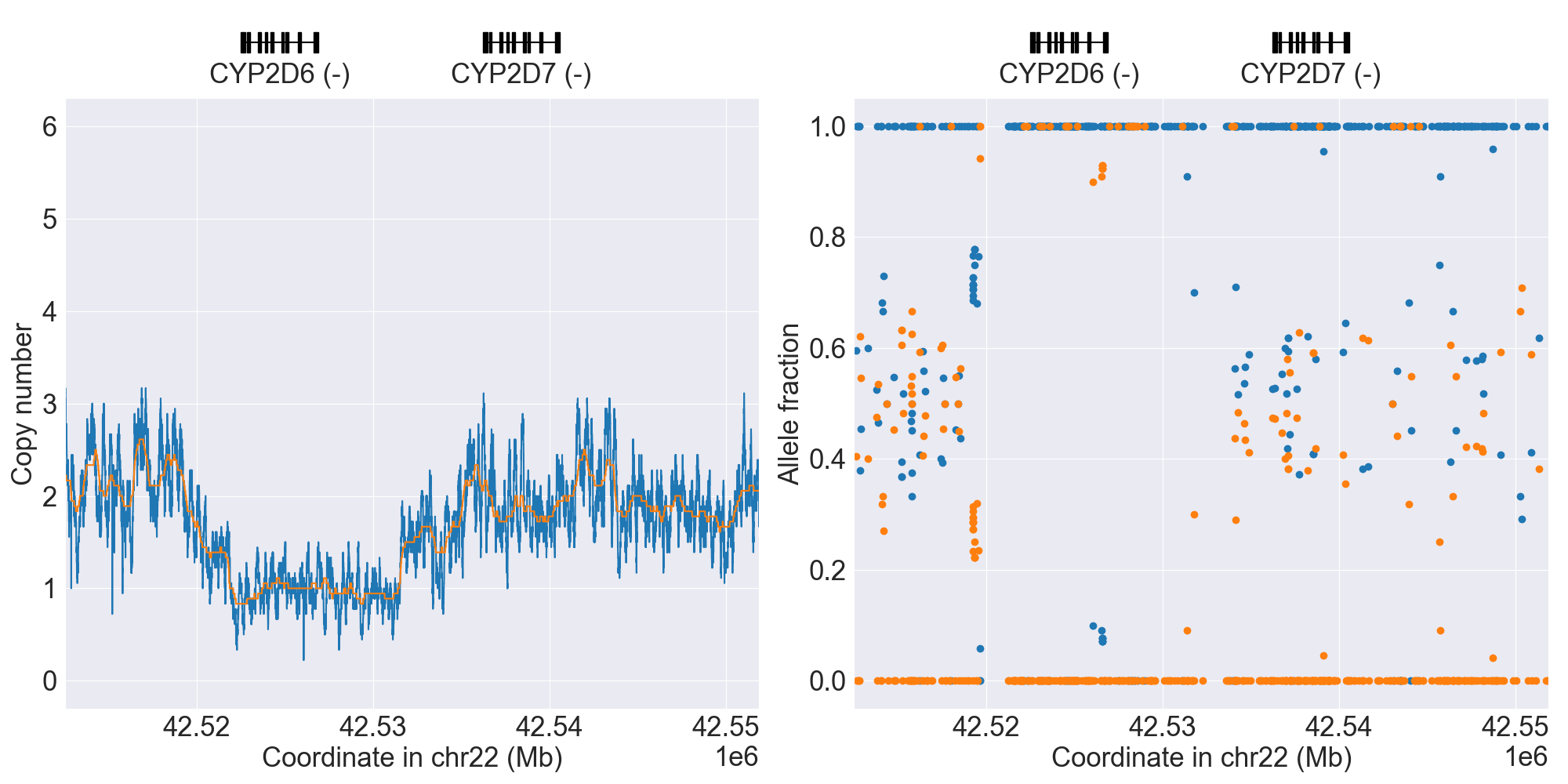
|
DeletionHom |

|
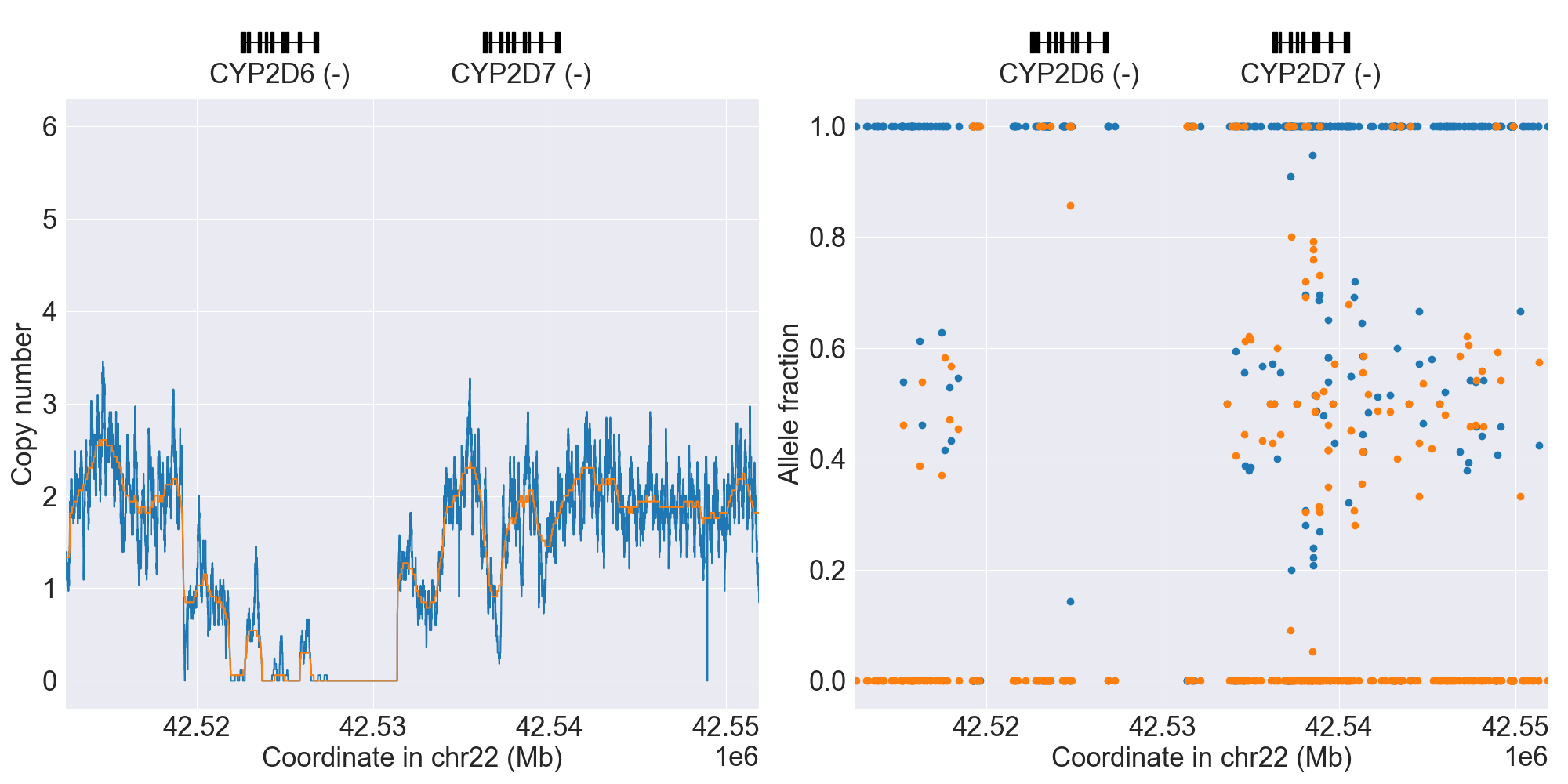
|
Duplication |

|

|
Tandem3 |

|
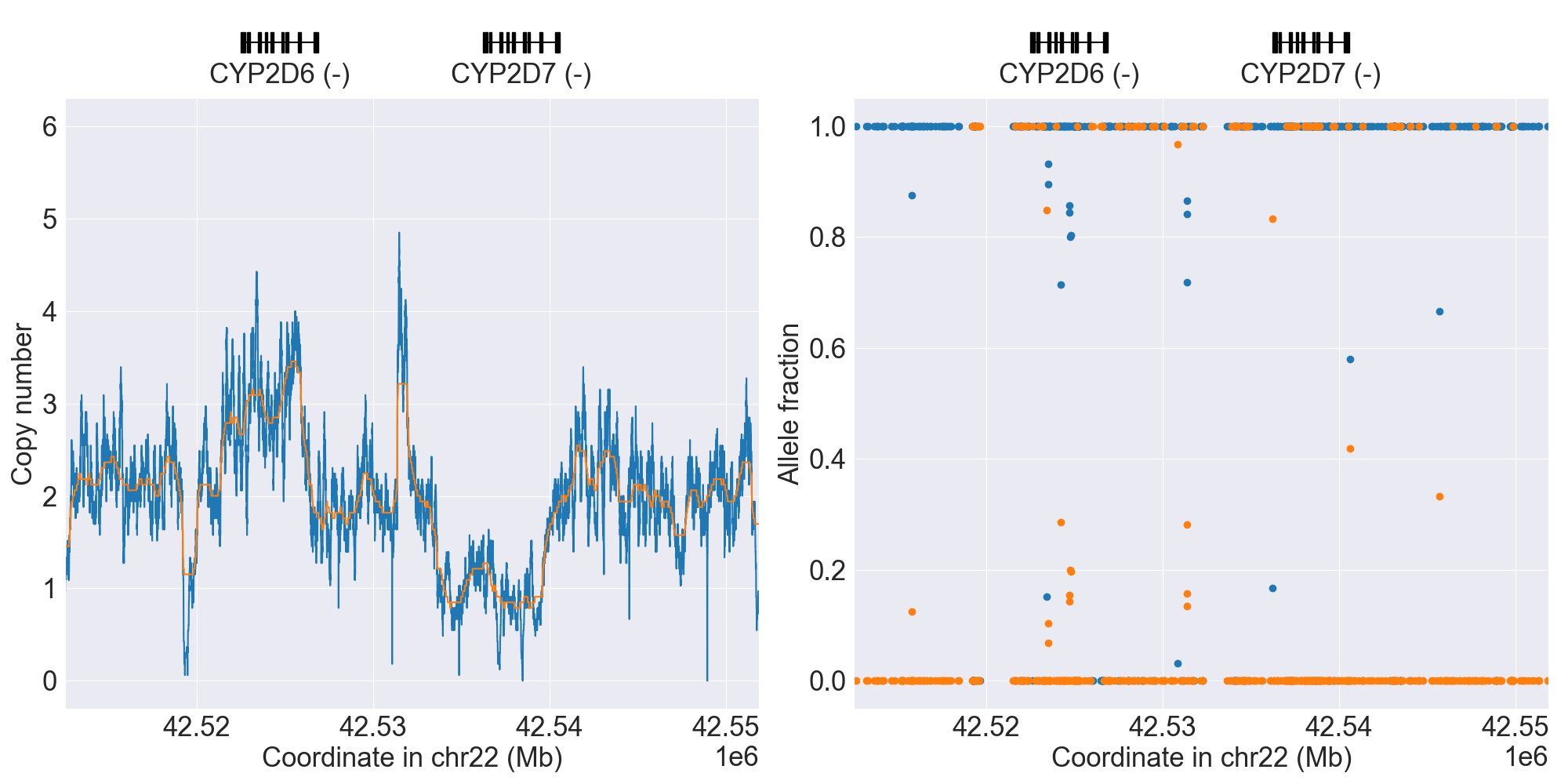
|
Tandem2C |

|
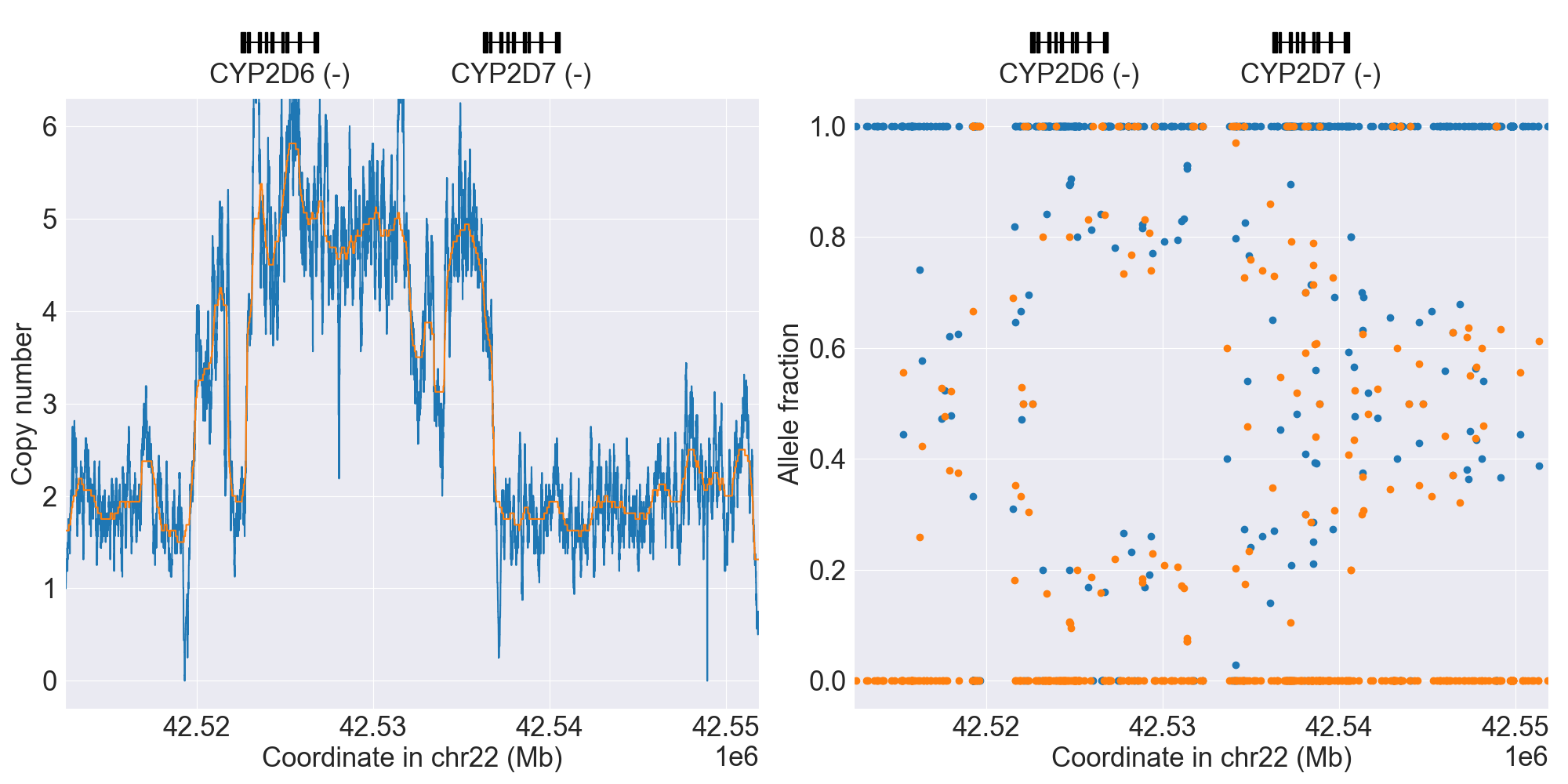
|
GRCh37 vs. GRCh38
When working with PGx data, it’s not uncommon to encounter a situation where you are handling GRCh37 data in one project but GRCh38 in another. You may be tempted to use tools like LiftOver to convert GRCh37 to GRCh38, or vice versa, but deep down you know it’s going to be a mess (and please don’t do this). The good news is, PyPGx supports both of the builds!
In many PyPGx actions, you can simply indicate which genome build to use. For example, for GRCh38 data you can use --assembly GRCh38 in CLI and assembly='GRCh38' in API. Note that GRCh37 will always be the default. Below is an example of using the API:
>>> import pypgx
>>> pypgx.list_variants('CYP2D6', alleles=['*4'], assembly='GRCh37')
['22-42524947-C-T']
>>> pypgx.list_variants('CYP2D6', alleles=['*4'], assembly='GRCh38')
['22-42128945-C-T']However, there is one important caveat to consider if your sequencing data is GRCh38. That is, sequence reads must be aligned only to the main contigs (i.e. chr1, chr2, …, chrX, chrY), and not to the alternative (ALT) contigs such as chr1_KI270762v1_alt. This is because the presence of ALT contigs reduces the sensitivity of variant calling and many other analyses including SV detection. Therefore, if you have sequencing data in GRCh38, make sure it’s aligned to the main contigs only.
The only exception to above rule is the GSTT1 gene, which is located on chr22 for GRCh37 but on chr22_KI270879v1_alt for GRCh38. This gene is known to have an extremely high rate of gene deletion polymorphism in the population and thus requires SV analysis. Therefore, if you are interested in genotyping this gene with GRCh38 data, then you must include that contig when performing read alignment. To this end, you can easily filter your reference FASTA file before read alignment so that it only contains the main contigs plus the ALT contig. If you don’t know how to do this, here’s one way using the fuc program (which should have already been installed along with PyPGx):
$ cat contigs.list
chr1
chr2
...
chrX
chrY
chr22_KI270879v1_alt
$ fuc fa-filter in.fa --contigs contigs.list > out.faArchive file, semantic type, and metadata
In order to efficiently store and transfer data, PyPGx uses the ZIP archive file format (.zip) which supports lossless data compression. Each archive file created by PyPGx has a metadata file (metadata.txt) and a data file (e.g. data.tsv, data.vcf). A metadata file contains important information about the data file within the same archive, which is expressed as pairs of =-separated keys and values (e.g. Assembly=GRCh37):
Metadata |
Description |
Examples |
|---|---|---|
Assembly |
Reference genome assembly. |
GRCh37, GRCh38 |
Control |
Control gene. |
VDR, chr1:10000-20000 |
Gene |
Target gene. |
CYP2D6, GSTT1 |
Platform |
Genotyping platform. |
WGS, Targeted, Chip, LongRead |
Program |
Name of the phasing program. |
Beagle, SHAPEIT |
Samples |
Samples used for inter-sample normalization. |
NA07000,NA10854,NA11993 |
SemanticType |
Semantic type of the archive. |
CovFrame[CopyNumber], Model[CNV] |
Notably, all archive files have defined semantic types, which allows us to ensure that the data that is passed to a PyPGx command (CLI) or method (API) is meaningful for the operation that will be performed. Below is a list of currently defined semantic types:
- CovFrame[CopyNumber]
CovFrame for storing target gene’s per-base copy number which is computed from read depth with control statistics.
Requires following metadata: Gene, Assembly, SemanticType, Platform, Control, Samples.
- CovFrame[DepthOfCoverage]
CovFrame for storing read depth for all target genes with SV.
Requires following metadata: Assembly, SemanticType, Platform.
- CovFrame[ReadDepth]
CovFrame for storing read depth for single target gene.
Requires following metadata: Gene, Assembly, SemanticType, Platform.
- Model[CNV]
Model for calling CNV in target gene.
Requires following metadata: Gene, Assembly, SemanticType, Control.
- SampleTable[Alleles]
TSV file for storing target gene’s candidate star alleles for each sample.
Requires following metadata: Platform, Gene, Assembly, SemanticType, Program.
- SampleTable[CNVCalls]
TSV file for storing target gene’s CNV call for each sample.
Requires following metadata: Gene, Assembly, SemanticType, Control.
- SampleTable[Genotypes]
TSV file for storing target gene’s genotype call for each sample.
Requires following metadata: Gene, Assembly, SemanticType.
- SampleTable[Phenotypes]
TSV file for storing target gene’s phenotype call for each sample.
Requires following metadata: Gene, SemanticType.
- SampleTable[Results]
TSV file for storing various results for each sample.
Requires following metadata: Gene, Assembly, SemanticType.
- SampleTable[Statistcs]
TSV file for storing control gene’s various statistics on read depth for each sample. Used for converting target gene’s read depth to copy number.
Requires following metadata: Control, Assembly, SemanticType, Platform.
- VcfFrame[Consolidated]
VcfFrame for storing target gene’s consolidated variant data.
Requires following metadata: Platform, Gene, Assembly, SemanticType, Program.
- VcfFrame[Imported]
VcfFrame for storing target gene’s raw variant data.
Requires following metadata: Platform, Gene, Assembly, SemanticType.
- VcfFrame[Phased]
VcfFrame for storing target gene’s phased variant data.
Requires following metadata: Platform, Gene, Assembly, SemanticType, Program.
Phenotype prediction
Many genes in PyPGx have a genotype-phenotype table available from the Clinical Pharmacogenetics Implementation Consortium (CPIC) or the Pharmacogenomics Knowledge Base (PharmGKB). PyPGx uses these tables to perform phenotype prediction with one of the two methods:
Method 1. Simple diplotype-phenotype mapping: This method directly uses the diplotype-phenotype mapping as defined by CPIC or PharmGKB. Using the CYP2B6 gene as an example, the diplotypes *6/*6, *1/*29, *1/*2, *1/*4, and *4/*4 correspond to Poor Metabolizer, Intermediate Metabolizer, Normal Metabolizer, Rapid Metabolizer, and Ultrarapid Metabolizer.
Method 2. Summation of haplotype activity scores: This method uses a standard unit of enzyme activity known as an activity score. Using the CYP2D6 gene as an example, the fully functional reference *1 allele is assigned a value of 1, decreased-function alleles such as *9 and *17 receive a value of 0.5, and nonfunctional alleles including *4 and *5 have a value of 0. The sum of values assigned to both alleles constitutes the activity score of a diplotype. Consequently, subjects with *1/*1, *1/*4, and *4/*5 diplotypes have an activity score of 2 (Normal Metabolizer), 1 (Intermediate Metabolizer), and 0 (Poor Metabolizer), respectively.
Please visit the Genes page to see the list of genes with a genotype-phenotype table and each of their prediction method.
To perform phenotype prediction with the API, you can use the pypgx.predict_phenotype method:
>>> import pypgx
>>> pypgx.predict_phenotype('CYP2D6', '*4', '*5') # Both alleles have no function
'Poor Metabolizer'
>>> pypgx.predict_phenotype('CYP2D6', '*5', '*4') # The order of alleles does not matter
'Poor Metabolizer'
>>> pypgx.predict_phenotype('CYP2D6', '*1', '*22') # *22 has uncertain function
'Indeterminate'
>>> pypgx.predict_phenotype('CYP2D6', '*1', '*1x2') # Gene duplication
'Ultrarapid Metabolizer'To perform phenotype prediction with the CLI, you can use the call-phenotypes command. It takes a SampleTable[Genotypes] file as input and outputs a SampleTable[Phenotypes] file:
$ pypgx call-phenotypes genotypes.zip phenotypes.zipPipelines
PyPGx currently provides three pipelines for performing PGx genotype analysis of single gene for one or multiple samples: NGS pipeline, chip pipeline, and long-read pipeline. In additional to genotyping, each pipeline will perform phenotype prediction based on genotype results. All pipelines are compatible with both GRCh37 and GRCh38 (e.g. for GRCh38 use --assembly GRCh38 in CLI and assembly='GRCh38' in API).
NGS pipeline
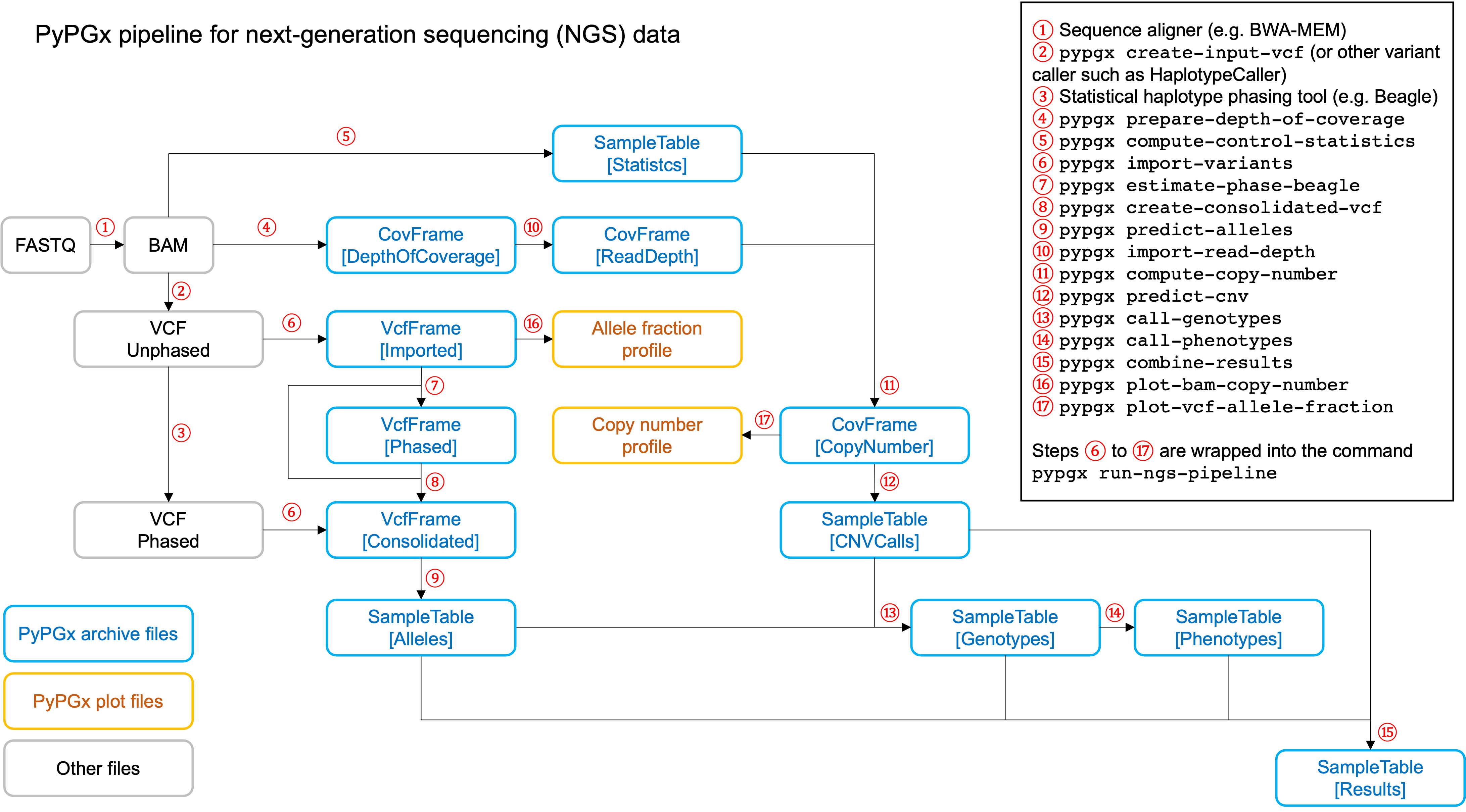
Implemented as pypgx run-ngs-pipeline in CLI and pypgx.pipeline.run_ngs_pipeline in API, this pipeline is designed for processing short-read data (e.g. Illumina). Users must specify whether the input data is from whole genome sequencing (WGS) or targeted sequencing (custome targeted panel sequencing or whole exome sequencing).
This pipeline supports SV detection based on copy number analysis for genes that are known to have SV. Therefore, if the target gene is associated with SV (e.g. CYP2D6) it’s strongly recommended to provide a CovFrame[DepthOfCoverage] file and a SampleTable[Statistcs] file in addtion to a VCF file containing SNVs/indels. If the target gene is not associated with SV (e.g. CYP3A5) providing a VCF file alone is enough. You can visit the Genes page to see the full list of genes with SV. For details on SV detection algorithm, please see the Structural variation detection section.
Chip pipeline
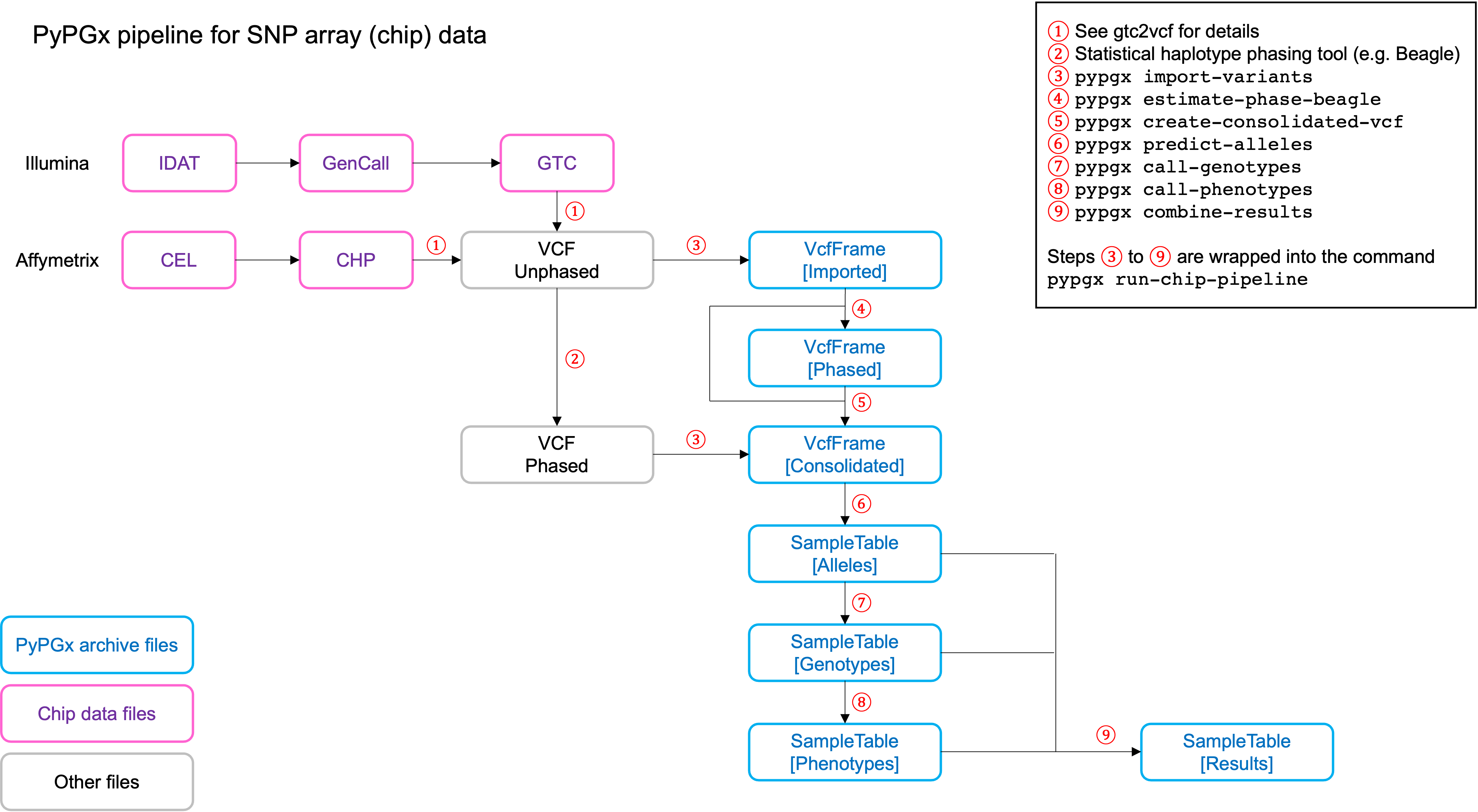
Implemented as pypgx run-chip-pipeline in CLI and pypgx.pipeline.run_chip_pipeline in API, this pipeline is designed for DNA chip data (e.g. Global Screening Array from Illumina). It’s recommended to perform variant imputation on the input VCF prior to feeding it to the pipeline using a large reference haplotype panel (e.g. TOPMed Imputation Server). Alternatively, it’s possible to perform variant imputation with the 1000 Genomes Project (1KGP) data as reference within PyPGx using --impute in CLI and impute=True in API.
The pipeline currently does not support SV detection. Please post a GitHub issue if you want to contribute your development skills and/or data for devising an SV detection algorithm.
Long-read pipeline
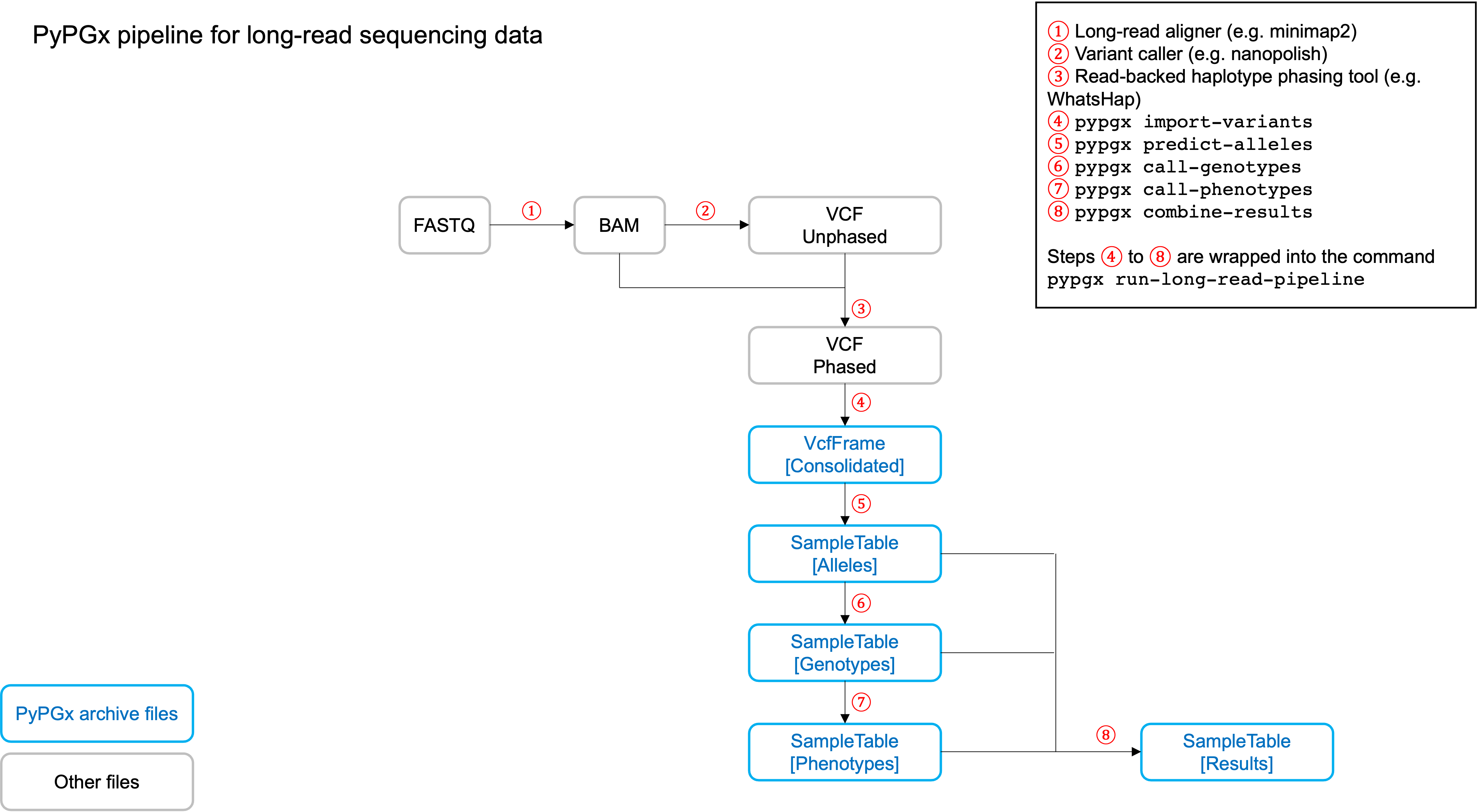
Implemented as pypgx run-long-read-pipeline in CLI and pypgx.pipeline.run_long_read_pipeline in API, this pipeline is designed for long-read data (e.g. Pacific Biosciences and Oxford Nanopore Technologies). The input VCF must be phased using a read-backed haplotype phasing tool such as WhatsHap.
The pipeline currently does not support SV detection. Please post a GitHub issue if you want to contribute your development skills and/or data for devising an SV detection algorithm.
Getting help
For detailed documentations on the CLI and API, please refer to the Read the Docs.
For getting help on the CLI:
$ pypgx -h
usage: pypgx [-h] [-v] COMMAND ...
positional arguments:
COMMAND
call-genotypes Call genotypes for target gene.
call-phenotypes Call phenotypes for target gene.
combine-results Combine various results for target gene.
compare-genotypes Calculate concordance between two genotype results.
compute-control-statistics
Compute summary statistics for control gene from BAM
files.
compute-copy-number
Compute copy number from read depth for target gene.
compute-target-depth
Compute read depth for target gene from BAM files.
create-consolidated-vcf
Create a consolidated VCF file.
create-regions-bed Create a BED file which contains all regions used by
PyPGx.
estimate-phase-beagle
Estimate haplotype phase of observed variants with
the Beagle program.
filter-samples Filter Archive file for specified samples.
import-read-depth Import read depth data for target gene.
import-variants Import SNV/indel data for target gene.
plot-bam-copy-number
Plot copy number profile from CovFrame[CopyNumber].
plot-bam-read-depth
Plot read depth profile with BAM data.
plot-cn-af Plot both copy number profile and allele fraction
profile in one figure.
plot-vcf-allele-fraction
Plot allele fraction profile with VCF data.
plot-vcf-read-depth
Plot read depth profile with VCF data.
predict-alleles Predict candidate star alleles based on observed
variants.
predict-cnv Predict CNV from copy number data for target gene.
prepare-depth-of-coverage
Prepare a depth of coverage file for all target
genes with SV from BAM files.
print-metadata Print the metadata of specified archive.
run-chip-pipeline Run genotyping pipeline for chip data.
run-long-read-pipeline
Run genotyping pipeline for long-read sequencing data.
run-ngs-pipeline Run genotyping pipeline for NGS data.
test-cnv-caller Test CNV caller for target gene.
train-cnv-caller Train CNV caller for target gene.
optional arguments:
-h, --help Show this help message and exit.
-v, --version Show the version number and exit.For getting help on a specific command (e.g. call-genotypes):
$ pypgx call-genotypes -hBelow is the list of submodules available in the API:
core : The core submodule is the main suite of tools for PGx research.
genotype : The genotype submodule is primarily used to make final diplotype calls by interpreting candidate star alleles and/or detected structural variants.
pipeline : The pipeline submodule is used to provide convenient methods that combine multiple PyPGx actions and automatically handle semantic types.
plot : The plot submodule is used to plot various kinds of profiles such as read depth, copy number, and allele fraction.
utils : The utils submodule contains main actions of PyPGx.
For getting help on a specific submodule (e.g. utils):
>>> from pypgx.api import utils
>>> help(utils)For getting help on a specific method (e.g. predict_phenotype):
>>> import pypgx
>>> help(pypgx.predict_phenotype)In Jupyter Notebook and Lab, you can see the documentation for a python function by hitting SHIFT + TAB. Hit it twice to expand the view.
CLI examples
We can print the metadata of an archive file:
$ pypgx print-metadata grch37-depth-of-coverage.zipAbove will print:
Assembly=GRCh37
SemanticType=CovFrame[DepthOfCoverage]
Platform=WGSWe can run the NGS pipeline for the CYP2D6 gene:
$ pypgx run-ngs-pipeline \
CYP2D6 \
grch37-CYP2D6-pipeline \
--variants grch37-variants.vcf.gz \
--depth-of-coverage grch37-depth-of-coverage.zip \
--control-statistics grch37-control-statistics-VDR.zipAbove will create a number of archive files:
Saved VcfFrame[Imported] to: grch37-CYP2D6-pipeline/imported-variants.zip
Saved VcfFrame[Phased] to: grch37-CYP2D6-pipeline/phased-variants.zip
Saved VcfFrame[Consolidated] to: grch37-CYP2D6-pipeline/consolidated-variants.zip
Saved SampleTable[Alleles] to: grch37-CYP2D6-pipeline/alleles.zip
Saved CovFrame[ReadDepth] to: grch37-CYP2D6-pipeline/read-depth.zip
Saved CovFrame[CopyNumber] to: grch37-CYP2D6-pipeline/copy-number.zip
Saved SampleTable[CNVCalls] to: grch37-CYP2D6-pipeline/cnv-calls.zip
Saved SampleTable[Genotypes] to: grch37-CYP2D6-pipeline/genotypes.zip
Saved SampleTable[Phenotypes] to: grch37-CYP2D6-pipeline/phenotypes.zip
Saved SampleTable[Results] to: grch37-CYP2D6-pipeline/results.zipAPI examples
We can obtain allele function for the CYP2D6 gene:
>>> import pypgx
>>> pypgx.get_function('CYP2D6', '*1')
'Normal Function'
>>> pypgx.get_function('CYP2D6', '*4')
'No Function'
>>> pypgx.get_function('CYP2D6', '*22')
'Uncertain Function'
>>> pypgx.get_function('CYP2D6', '*140')
'Unknown Function'We can predict phenotype for the CYP2D6 gene based on two haplotype calls:
>>> import pypgx
>>> pypgx.predict_phenotype('CYP2D6', '*4', '*5') # Both alleles have no function
'Poor Metabolizer'
>>> pypgx.predict_phenotype('CYP2D6', '*5', '*4') # The order of alleles does not matter
'Poor Metabolizer'
>>> pypgx.predict_phenotype('CYP2D6', '*1', '*22') # *22 has uncertain function
'Indeterminate'
>>> pypgx.predict_phenotype('CYP2D6', '*1', '*1x2') # Gene duplication
'Ultrarapid Metabolizer'Project details
Release history Release notifications | RSS feed
Download files
Download the file for your platform. If you're not sure which to choose, learn more about installing packages.











